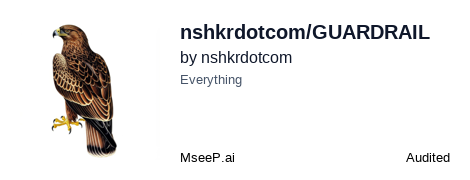About
GUARDRAIL provides a multi‑layered security framework that protects traditional web, data infrastructure, LLM applications, and Model Context Protocol (MCP) agents through message classification, trust scoring, and flow control. It helps teams assess gaps, prioritize controls, and secure end‑to‑end LLM workflows.
Capabilities

Guardrail – A Layered Security Framework for LLM‑Powered Applications
Guardrail is a Model Context Protocol (MCP) server that provides a structured, onion‑shaped security model specifically designed for large language model (LLM) applications and autonomous agents. It addresses the gap that arises when traditional web security practices are extended to AI‑centric workloads, ensuring that every layer of an application stack is protected against both conventional and emerging threats.
The core problem Guardrail solves is the lack of a unified, protocol‑level guard against prompt injection, jailbreak attempts, data leakage, and misbehaviour of autonomous agents. In many AI deployments, developers patch individual components—input sanitizers, output filters, or container hardening—without a cohesive strategy. Guardrail compiles these disparate safeguards into a single MCP‑exposed service that can be queried, enforced, and audited across the entire application lifecycle. This centralization reduces configuration drift, simplifies compliance reporting, and gives developers a single point of control for security policies that span from the web layer all the way to agent communication.
Key capabilities of Guardrail include:
- Layered Security Onion: A visual and logical representation of four security layers—traditional web, data & infrastructure, LLM application, and agent/MCP. Each layer maps to concrete controls such as authentication, database encryption, prompt sanitization, and message classification.
- Policy Engine: An MCP endpoint that evaluates incoming prompts or agent messages against a set of declarative rules. Rules can enforce content constraints, rate limits, and contextual trust scores.
- Audit & Traceability: Every security decision is logged with a unique identifier, enabling forensic analysis and compliance audits. The audit trail is accessible through MCP resources, making it easy to integrate with existing observability stacks.
- Dynamic Configuration: Security rules can be updated on the fly via MCP, allowing teams to respond quickly to new attack vectors without redeploying code.
Guardrail shines in real‑world scenarios where AI systems interact with sensitive data or operate autonomously. For example, a customer support chatbot that pulls personal records from a database can use Guardrail to ensure prompts cannot leak private information. In an autonomous trading agent, Guardrail’s MCP flow control can prevent malicious commands from being executed by enforcing trust scores and contextual checks before actions are taken. By embedding security directly into the communication protocol, Guardrail eliminates many of the pitfalls that arise when security is treated as an afterthought.
Integration with existing AI workflows is straightforward: developers expose Guardrail’s MCP endpoints alongside their model inference services. The MCP client libraries handle policy evaluation as part of the request pipeline, so developers need only add a single middleware layer. Because Guardrail operates at the protocol level, it is agnostic to the underlying LLM framework—whether you’re using OpenAI’s GPT series, Anthropic’s Claude, or an on‑premise model. This portability gives teams the flexibility to adopt Guardrail without locking into a specific vendor.
What sets Guardrail apart is its holistic, layered approach that mirrors the way real applications are built. Rather than offering a single “security wrapper,” it provides a comprehensive framework that scales with the complexity of modern AI systems. By treating security as a first‑class citizen in the MCP ecosystem, Guardrail empowers developers to build resilient, compliant LLM applications with confidence.
Related Servers
MarkItDown MCP Server
Convert documents to Markdown for LLMs quickly and accurately
Context7 MCP
Real‑time, version‑specific code docs for LLMs
Playwright MCP
Browser automation via structured accessibility trees
BlenderMCP
Claude AI meets Blender for instant 3D creation
Pydantic AI
Build GenAI agents with Pydantic validation and observability
Chrome DevTools MCP
AI-powered Chrome automation and debugging
Weekly Views
Server Health
Information
Tags
Explore More Servers
1Panel MCP Server
Automated website deployment to 1Panel via Model Context Protocol
Todoist MCP Server
Natural language task management for Todoist
Google Ads MCP Server
Seamless Google Ads API integration with OAuth 2.0 and keyword research
AniList MCP Server
LLM-powered access to anime, manga, and user data
Blender MCP Senpai
AI‑assisted Blender mentor for instant topology feedback
Bitbucket MCP Server
AI-powered Bitbucket repository assistant